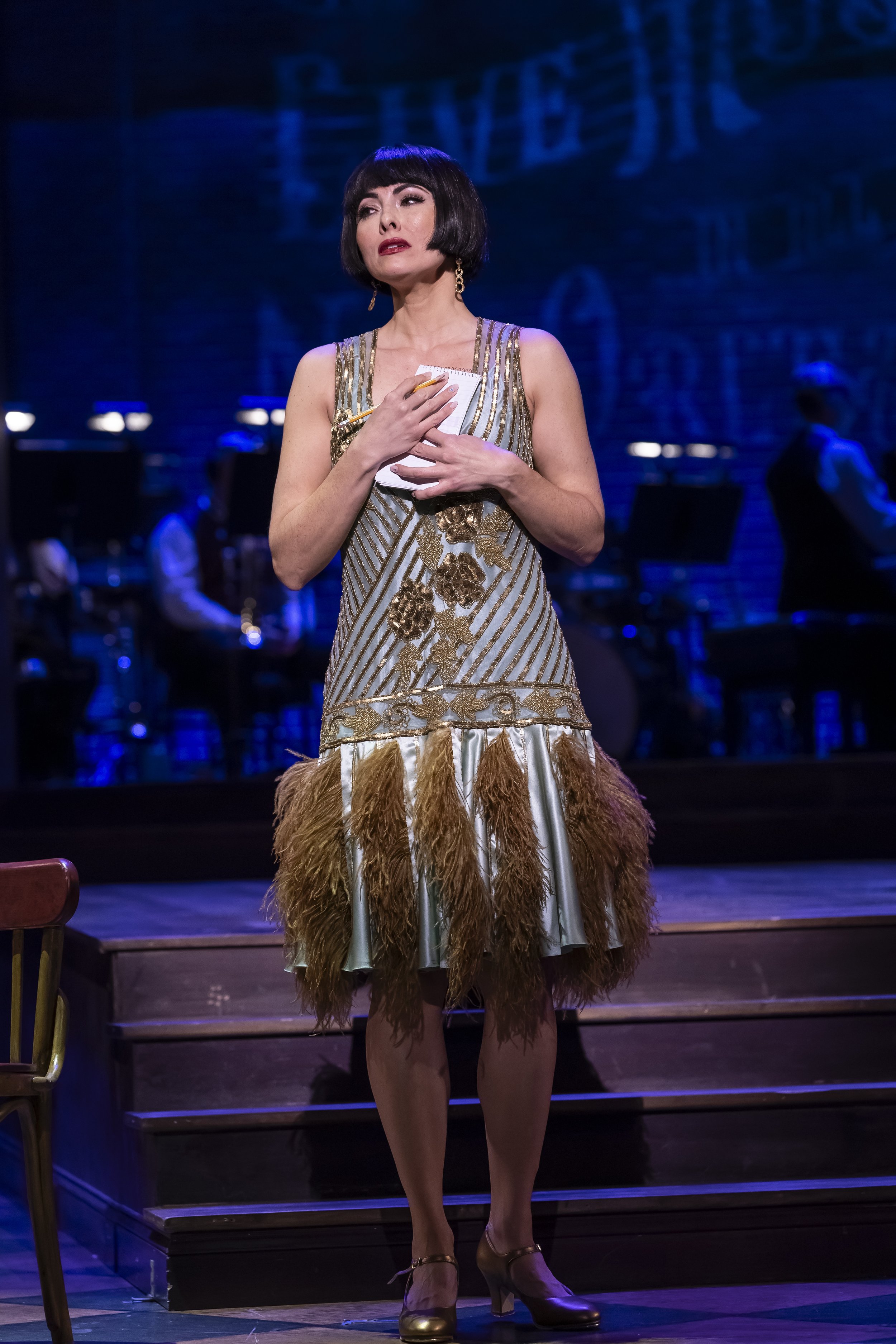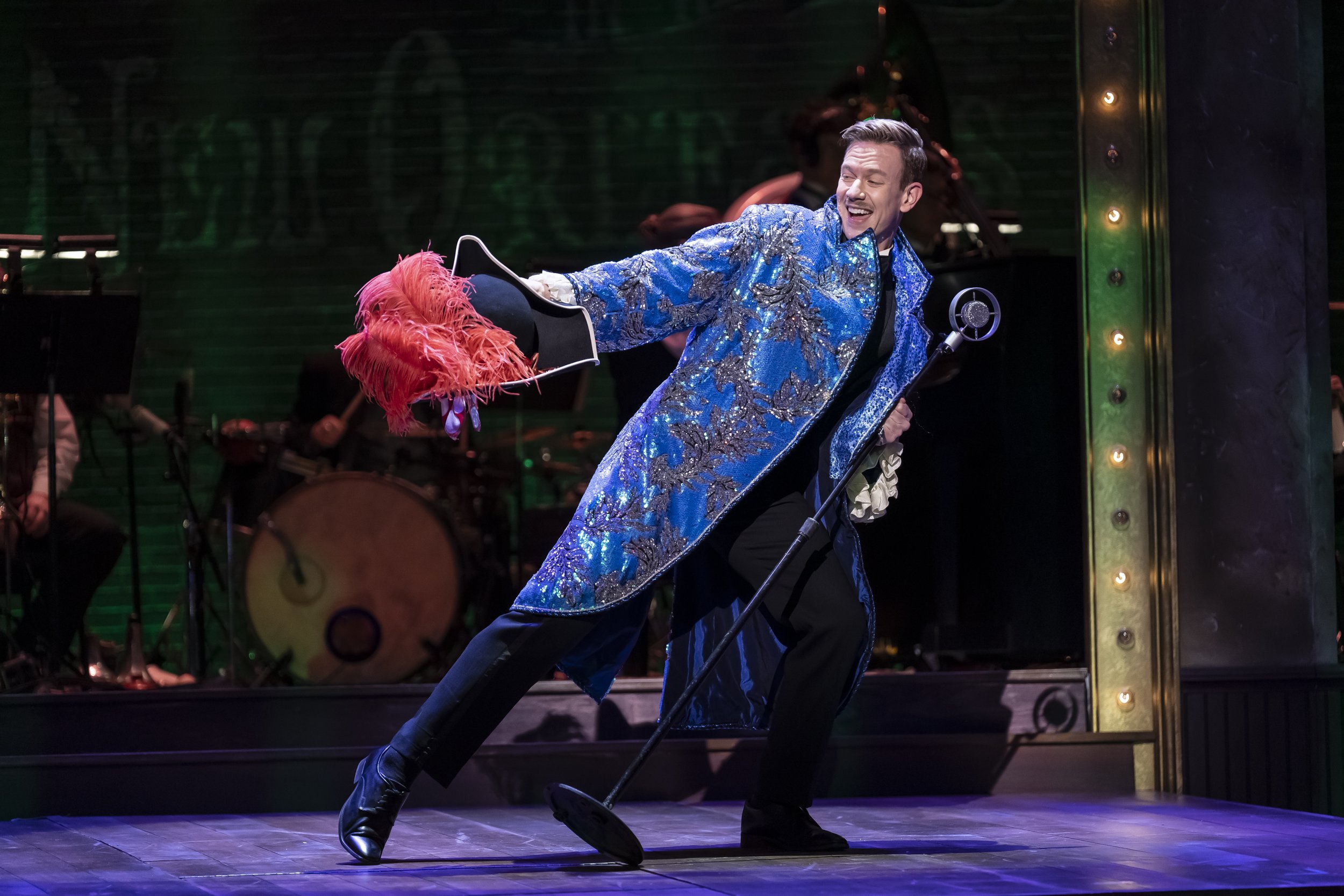First, let’s adjust expectations. Yes, Songbird was presented by Washington National Opera, but it is not an opera. Without knowing its history, I doubt you would think of it even as an operetta, though it is based on an operetta by an opera composer, the link that drew it into WNO’s fold. It is an in-your-face, high energy Broadway musical by way of Bourbon Street, a comic adult fairy tale produced in vaudevillian style. What it mostly is, is high entertainment, impressive in the quality, attention to detail, and professionalism shining from every aspect – composition, music, singing, acting, choreography, set design, staging, costumes, and lighting. It’s as though this group of talented performers and creative staff got together and said, “let’s knock their socks off”, and judged for what it is, they succeeded. WNO has been reaping the rewards; performances have been sold out or close to it.
Songbird (Isabel Leonard) and Piquillo (Ramin Karimloo) perform for tips. Photo by Scott Suchman; courtesy of Washington National Opera.
Songbird was a child of COVID. For the 2021 season, the Glimmerglass Festival, then under the direction of Francesca Zambello, WNO’s Artistic Director, decided to hold performances but modify them to meet with COVID restrictions – outdoors, fewer more spaced-out players, and short in length, no intermissions to avoid crowds at bathrooms. Remember those days; still got your masks? Hence, the 75-minute Songbird was born, based on the storyline and melodies from Jacques Offenbach’s operetta, La Périchole (1868), a work successful at the time and sometimes performed today, particularly in Europe; the Met Opera last performed it in 1971, but more frequently performs Offenbach’s opera, The Tales of Hoffman. The locale was moved from Offenbach’s imagined Lima, Peru to New Orleans to allow for Kelley Rourke to write the libretto for this reduced version in English but also include French as one might encounter in New Orleans. She gave the street singer La Périchole the moniker of Songbird; this songbird not only sings beautifully but has some fight in her. Ms. Rourke is the Artistic Advisor for Washington National Opera’s American Opera Initiative and resident dramaturg for The Glimmerglass Festival. Her libretto for Songbird is masterful.
The speakeasy performers prepare for a wedding Mardi Gras style with Mayor Don Andrès (Edward Nelson) in the center wearing a crown. Photo by Scott Suchman; courtesy of Washington National Opera.
The setting for Songbird is a 1920s speakeasy during the prohibition era, giving the villain, the mayor, more power over the staff and patrons there. The mayor dressed in a disguise to spy on how things are going, and fooling no one, lurks about as a young romantic couple, Songbird and Piquillo, enter to sing for their supper, but the tips are scarce. Piquillo leaves to find food and an exhausted Songbird sits down to sleep. Mayor Don Andrès moves in to seduce Songbird with food and money, with a little libation to ease the path. She momentarily consents to go with him for food, though never intending to sacrifice her virtue or her relationship with Piquillo. An implausible series of events follows - a letter from Songbird to Piquillo expressing regrets, a sham marriage between the two, one disguised and both tipsy and not recognizing each other at the time, a jail term and escape, and a real marriage for a happy ending. It is mostly played for laughs and goes down fast.
The Songbird band playing in the New Orleans speakeasy with Conductor James Lowe on the right. Photo by Scott Suchman; courtesy of Washington National Opera.
Director Eric Sean Fogel kept the pace moving and the movements were well-choreographed, including the dancing, quite a feat working with a single set as a site of all the action, especially considering there was a lot of action. The move of Songbird from the grass of Glimmerglass to the Eisenhower Theater stage led to a great deal of embellishment of the set, an authentic looking New Orleans speakeasy, in Mardi Gras colors; kudos to Set & Props Designer James F. Rotondo III. The set was bathed in atmospheric lighting throughout thanks to Lighting Designer Robert Wierzel. For this performance style, the singers wore mikes inconspicuously, and the sound was controlled well by Sound Designer Mark Rivet. The orchestra was placed in an elevated cove in the back of the set. The delightful costumes of Costume Designers Marsha LeBoeuf and Timm Burrow were also Mardi Gras-esque, including the flapper dress for Songbird.
l to r: Don Pedro (Jonathan Patton) and Mayor Don Andrès (Edward Nelson) watch as a tipsy Songbird (Isabel Leonard) struggles to remain upright. Photo by Scott Suchman; courtesy of Washington National Opera.
If I were to offer any significant criticism of Songbird, it would be that it goes two-thirds of the work in enjoyable but unrelenting fashion, sort of like starting your dinner at Commander’s Palace with dessert and they serve you Bananas Foster and then they bring out Creole Bread Pudding immediately followed by Praline Parfait. I was wanting some nice warm soup, but it wasn’t until Piquillo is alone in jail suffering from the loss of Songbird that we have a chance to relax and absorb the drama and romance gone awry, before moving to warp speed again.
Piquillo (Ramin Karimloo) being shepherded to the altar by Don Pedro (Jonathan Patton) on table and Panatellas (Sahel Salam) seated. Photo by Scott Suchman; courtesy of Washington National Opera.
The person who made the clever suggestion to use a New Orleans jazz band instead of a French chamber orchestra was Conductor James Lowe who also was responsible for the musical arrangement and orchestration. The 11-performer group included only two strings, one a bass and the other a banjo, and it featured a sousaphone, a type of tuba that Mardi Gras marchers can wear over their shoulders. A performer specially added was jazz pianist Jo Ann Daugherty. At one point, clarinetist David Jones stepped out of the group to match vocal riffs by the mayor before slinking back into the band. The band played on and played well, great fun and very reminiscent of New Orleans; I would go to that club.
left: Songbird (Isabel Leonard) holding the letter she has composed for her true love. right: Mayor Don Andrès (Edward Nelson) dons another costume. Photos by Scott Suchman; courtesy of Washington National Opera.
The star of the show was, of course the fabulous Isabel Leonard, an opera superstar and frequent visitor to WNO. She was terrific, a perfect songbird, in both singing and acting and even threw in a little tap dancing. Her character Songbird was the heart and moral backbone of the story; when she told the sleazy mayor he wasn’t going to get what he wanted, the audience broke into applause. I was not surprised to see Ms. Leonard in a Broadway style musical. She played Carmen in WNO’s 2022 production but before that, she performed at WNO’s welcome back from COVID celebration in 2021, bringing down the house singing Jeanne Tesori’s “the girl in 14G”. Her partner on stage playing Piquillo was Ramin Karimloo, a popular London West End and Broadway star, including leading roles in the Funny Girl revival and Les Misérables (for which he received a Tony Award nomination). He covers both low tenor and high baritone roles. His Broadway spit and polish was obvious in his acting and his attractive, nuanced vocals, a huge positive addition to the cast. The other lead performer was baritone Edward Nelson who was almost shockingly good in both singing and acting as the womanizing mayor. I had forgotten he appeared in WNO’s Candide a few years back, but his credits are mostly hard-core opera baritone roles. I guess we can call him a crossover artist…now I’d like to see him as Don Giovanni.
l to r: The Three Muses (Kresley Figueroa, Cecelia McKinley, and Teresa Perrotta). Photo by Scott Suchman; courtesy of Washington National Opera.
The remainder of the cast was mainly the highly talented Cafritz Young Artists and mezzo-soprano Taylor-Alexis Dupont who played the performer Celeste; all contributed handsomely. The three muses were played by Teresa Perrotta, Kresley Figueroa, and Cecilia McKinley. Jonathan Pierce Rhodes played the role of Priest and Justin Burgess the role of a local tough guy who made fun of Piquillo’s predicament. Standouts were Justin Burgess as Don Pedro the manager of the speakeasy and Sahel Salam, his partner in chicanery. I thought Mr. Salam showed a spark ready for a TV sitcom.
I thoroughly enjoyed Songbird as over the top entertainment. It was fun just to see this cast and creative team at work. Not that it needed it, but in this step to the side of opera, Isabel Leonard moved her star even higher in the pantheon. In his program comments, WNO’s General Director stated, “As you know, we are trying to expand the horizons of how we produce opera, whether it be in content, casting, interpretation, or actual production”. Songbird has made me sit up and take notice. We are already promised a new ending in WNO’s Turandot coming up next. What new wrinkles might be coming in the 2024-2025 season?
The Fan Experience: Performances of Songbird in the Eisenhower Theater were scheduled for March 9, 11, 15, 17, 20, and 23. The libretto is mainly in English with French mixed in, and lyrics are shown on the overhead screen; run time was about 75 minutes with no intermission.
WNO’s Turandot will run May 11, 13, 17, 19, 22, 24 and star Ewa Plonka as Turandot and Jonathan Burton as Calaf and will be directed with a new ending by Francesca Zambello. The 2024-2025 season has been announced at this link.
Parking in the Kennedy Center is typically plentiful at around $25 per day, with a small discount for Kennedy Center members when reserved ahead of the day. The Metro to Foggy Bottom and the free red Kennedy Center buses, from there to the Kennedy Center running every 15 minutes, are an excellent option. There is an advantage in getting there a bit early. KC frequently has multiple performances on its different stages overlapping that can create traffic jams.
There are snack stands in the main lobby, and on the Terrace level, the KC Café offers food cafeteria style at moderate prices; fine dining is available on the Terrace level in the Roof Terrace Restaurant. Food and drinks except water are not allowed inside the opera house, but you can purchase reusable capped containers with your drinks that you can take inside.








